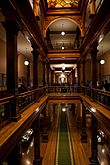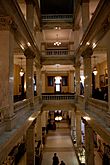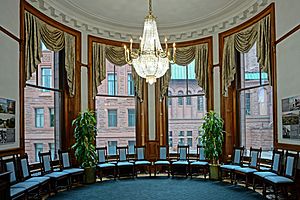Ontario Legislative Building facts for kids
Quick facts for kids Ontario Legislative Building |
|
|---|---|

The south façade of the Ontario Legislative Building
|
|
| General information | |
| Architectural style | Richardsonian Romanesque |
| Town or city | Toronto, Ontario |
| Country | Canada |
| Coordinates | 43°39′45″N 79°23′30″W / 43.662447°N 79.391708°W |
| Completed | 1893 |
| Client | The Queen in Right of Ontario |
| Owner | The Queen in Right of Ontario (building) University of Toronto (land) |
| Technical details | |
| Structural system | Iron and timber framing |
| Design and construction | |
| Architect | Richard A. Waite (main wing) George Wallace Gouinlock (north wing) E.J. Lennox (additional floors to west wing) |
The Ontario Legislative Building (French: L'édifice de l'Assemblée législative de l'Ontario) is an important building in downtown Toronto, Ontario, Canada. It is where the Legislative Assembly of Ontario meets. This is like the province's parliament.
The building also holds the offices for the Lieutenant Governor of Ontario. This person represents the King or Queen in Ontario. Many members of the provincial parliament (MPPs) also have their offices here.
The building is located in Queen's Park. This area was once part of the University of Toronto. The land is now leased to the government for a very small fee. People often call the building and the provincial government "Queen's Park."
Contents
What Does the Building Look Like?
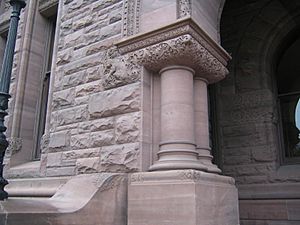
The Ontario Legislative Building was designed by Richard A. Waite. It has five floors and is built in the Richardsonian Romanesque style. This style uses strong, heavy stone and rounded arches.
The building's frame is made of iron, which helps it stand strong. Many of the materials used to build it came from Canada. For example, 10.5 million bricks were made by prisoners. The pink-coloured sandstone comes from the Credit River valley and Orangeville, Ontario. This pink stone is why the building is sometimes called The Pink Palace.
You can see many stone carvings on the outside. These include gargoyles and grotesques. The building also has very large windows. These were possible because of the strong iron frame inside.
The North Wing was added in 1909 by architect George Wallace Gouinlock. E.J. Lennox later added two more floors to the west wing.
The main front of the building faces south. The building's centre lines up with University Avenue. This means the Legislative Building is a grand sight at the end of that street. The main meeting room, called the Legislative Chamber, is right in the middle. It gets light from three large arched windows above the main entrance.
On each side of the main entrance are two towers with domes. The west tower was supposed to have a clock. But a rose window was put there instead because there wasn't enough money for the clock.
The building's south side looks a bit uneven today. The west wing was originally designed to have three floors and a pyramid-shaped roof, just like the east wing. But after a fire in 1909, the west side was rebuilt and made larger. It got an extra fourth floor with wall dormer windows.
The east and west wings turn north, forming a U-shape around a courtyard. In this courtyard is the 1909 North Wing.
Inside, a main hall runs from the south entrance to a grand staircase. From the middle of this staircase, you can reach the parliamentary library. At the top of the stairs is the lobby for the legislative chamber.
Wide hallways stretch east and west from this central area. The east wing looks more like the Victorian style from when it was built. It has dark wood panels. The west wing hallway is more Edwardian and Neoclassical. It has white marble walls, showing when it was built.
South of the building is an open area with many trees. This space is often used for public gatherings and protests. Other government offices are in separate buildings nearby.
The building is even featured on the album cover of the band Rush's 1981 album Moving Pictures.
Lieutenant Governor's Suite
In the north-west part of the building is the Lieutenant Governor's Suite. This has been the office of the Lieutenant Governor of Ontario since 1937. Before that, it was used as a dining room for government officials.
The suite has three floors. It has its own special staircase and elevator. These are used when members of the Canadian Royal Family or important visitors arrive. A rose garden is on the west side of the building. It was given by the Monarchist League of Canada in 1977.
Inside, there are reception rooms, a dining room for official events, offices for staff, and a kitchen. The furniture and lights came from the previous government house, Chorley Park. Paintings come from the Government of Ontario Art Collection and the Toronto Public Library. Sometimes, special art shows are held here.
The Music Room is the biggest space in the suite. It is used for special events like New Years' Levées. New cabinet ministers are sworn in here. Also, provincial honours are given out in this room.
Portraits in the Suite
The suite displays portraits of past Lieutenant Governors of Ontario. It also has:
- A portrait of Queen Elizabeth II and The Duke of Edinburgh, and the current Lieutenant Governor.
- A large portrait of Upper Canada's first Lieutenant Governor, John Graves Simcoe. This painting by Sir Edmund Wyly Grier is on loan from the Toronto Public Library.
History of Ontario's Parliament Buildings
Early Buildings
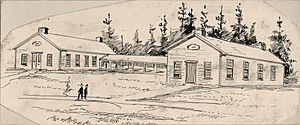
The current Ontario Legislative Building is the seventh building to serve as Ontario's parliament. The first meetings of the assembly happened in Newark, Upper Canada (now Niagara-on-the-Lake). This was in 1791.
Just three years later, construction began on a special parliament building in York (now Toronto). The Lieutenant Governor, John Graves Simcoe, thought it was too risky to have the capital so close to the United States border. The first buildings were simple wooden structures. They were called the Palace of Parliament.
However, the capital was still not safe. The Palace of Parliament was burned down on April 27, 1813. This happened during an attack on the city in the War of 1812. After this, the assembly met in different places. They met in a hotel and then in the home of a judge.
A new parliament building was built on the same site. But it only lasted four years. It was destroyed by an accidental fire on December 30, 1824.

From 1824 to 1829, the assembly met in the new York General Hospital. This delayed the hospital's opening. Then, they moved to the old Court House.
In 1832, a new building was constructed on Front Street. This served as the third parliament building for Upper Canada. It was used until 1840, when Upper Canada joined with Lower Canada to form the Province of Canada. The combined assembly then moved to Kingston.
Over the next few years, the assembly moved between Toronto, Montreal, and Quebec City. This constant moving made politicians unhappy. So, Queen Victoria was asked to choose a permanent capital. In 1857, she chose Bytown (which later became Ottawa).
Today, the site of the first parliament buildings in York is a parking lot. But in 2000, archaeologists found evidence of the old buildings. The land was then bought by the Ontario Heritage Trust. They ran a centre there from 2012 to 2015.
The Queen's Park Building
On July 1, 1867, the province of Canada joined with two others to form Canada. The province was split into Ontario and Quebec. New parliaments were set up for each. Toronto became the capital of Ontario.
The legislative assembly moved back to the Front Street property. This was the same place the Province of Canada's assembly had met. However, the building had been damaged by fire in 1861 and 1862.
By 1880, a request was made for designs for a new parliament building for Ontario. The chosen design by Richard A. Waite was approved in 1885. Construction began in 1886.
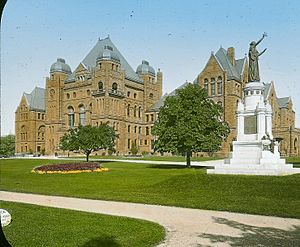
The Ontario Legislative Building officially opened on April 4, 1893. The Lieutenant Governor of Ontario, George Airey Kirkpatrick, opened it. The final cost was about CA$1,250,000. Some people thought the design looked "too American".
The old parliament building on Front Street was empty for almost ten years. It was torn down between 1900 and 1903. The land was then sold to a railway company. Today, the Canadian Broadcasting Centre and other buildings are on that site.
In 1909, a new wing was added to the north side of the Ontario Legislative Building. This enclosed the courtyard. While it was being built, a fire started on September 1. Workers repairing the roof accidentally caused it. The fire destroyed the inside of the west wing, including the library. Repairs and rebuilding took until 1912.
Later, more government buildings were built nearby. These include the Whitney Block (1925), the Macdonald and Hepburn Blocks (1968), and the Mowat and Hearst Blocks (1969).
Security at the Building
Security around the Legislative grounds is handled by the Legislative Security Service. This group took over from the Ontario Provincial Police. Since 2016, some members have carried handguns. The unit has 75 members. They report to the Sergeant-at-Arms and patrol both Queen's Park and the Whitney Block. Most officers in this unit are called Special Constables or Agents.
Portraits of the Premier
The Legislature also displays portraits of several past premiers (the head of the provincial government). These include:
- Bill Davis - by Istvan Nyikos
- Frank Miller - by Anthony Miles
- David Peterson - by Linda Kooluris Dobbs
- Bob Rae - Phil Richards
- Mike Harris - by Istvan Nyikos
- Ernie Eves - by Bernard Poulin
- Dalton McGuinty - by Istvan Nyikos
- Kathleen Wynne - by Linda Kooluris Dobbs
Images for kids
See also
 In Spanish: Edificio Legislativo de Ontario para niños
In Spanish: Edificio Legislativo de Ontario para niños


